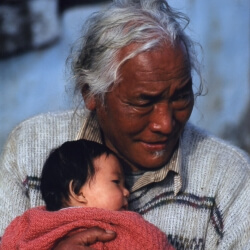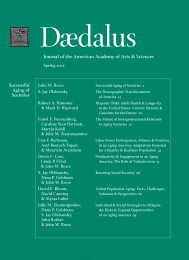
Successful Aging of Societies
As America ages, policy-makers’ preoccupations with the future costs of Medicare and Social Security grow. But neglected by this focus are critically important and broader societal issues such as intergenerational relations within society and the family, rising inequality and lack of opportunity, productivity in late life (work or volunteering), and human capital development (lifelong education and skills training). Equally important, there is almost no acknowledgment of the substantial benefits and potential of an aging society. The MacArthur Foundation Research Network on an Aging Society offers policy options to address these issues and enhance the transition to a cohesive, productive, secure, and equitable aging society. Such a society will not only function effectively at the societal level but will provide a context that facilitates the capacity of individuals to age successfully. This volume comprises a set of papers, many of which are authored by members of the MacArthur Network, focusing on various aspects of the opportunities and challenges facing the United States while it passes through its current demographic transformation. This essay provides a general overview of the strategy the Network has used to address the various components of this broad subject.
The Demographic Transformation of America
The face of aging in America is about to change. Within the next thirty years, the U.S. population will experience a permanent change in its age structure, and there is reason to believe that cohorts reaching older ages in the future will be far different from those reaching older ages today. In this essay, I explain why life expectancy in the United States is likely to diverge from that experienced by the rest of the developed world; describe recent trends in healthy life expectancy; and examine how the age structure of the United States will by mid-century be different from that found today.
Hispanic Older Adult Health & Longevity in the United States: Current Patterns & Concerns for the Future
The Hispanic population aged sixty-five and over – the most socioeconomically disadvantaged subset of America's elderly – is projected to quintuple between 2012 and 2050. While current longevity patterns for Hispanics relative to whites are favorable, old-age functioning and disability patterns for Hispanics are unfavorable and have serious implications for caregivers; families; and local, state, and federal governments. Troubling signs for the future Hispanic population (which are shared to varying degrees with other vulnerable groups) include the unresolved legal status of unauthorized immigrants, continued low levels of insurance coverage even after health care reform, some unfavorable trends in health behaviors, and continued disadvantages in educational attainment and income relative to whites. We urge policy-makers to deal with these potentially problematic health and well-being issues. Not doing so could have detrimental consequences for the future of the Hispanic population as well as other at-risk groups and, by extension, the U.S. elderly population as a whole.
The Future of Intergenerational Relations in Aging Societies
As the pressure mounts to reduce the public costs of supporting rapidly aging societies, responsibility for supporting elderly people will increasingly fall on their family members. This essay explores the family's capacity to respond to these growing challenges. In particular, we examine how family change and growing inequality pose special problems in developed nations, especially the United States. This essay mentions a series of studies supported by the MacArthur Foundation Research Network on an Aging Society that aim to examine the future of intergenerational exchange. We focus particularly on adults who have dependent and young-adult children and who must also care for elderly parents, a fraction of the population that will grow substantially in the coming twenty-five years.
Labor-Force Participation, Policies & Practices in an Aging America: Adaptation Essential for a Healthy & Resilient Population
Population aging in the United States poses challenges to societal institutions while simultaneously creating opportunities to build a more resilient, successful, and cohesive society. Work organization and labor-force participation are central to both the opportunities and challenges posed by our aging society. We argue that expectations about old age have not sufficiently adapted to the reality of aging today. Our institutions need more adaptation in order to successfully face the consequences of demographic change. Although this adaptation needs to focus especially on work patterns among the “younger elderly,” our society has to change its general attitudes toward work organization and labor-force participation, which will have implications for education and health care. We also show that work's beneficial effects on well-being in older ages are often neglected, while the idea that older workers displace younger workers is a misconception emerging from the “lump-of-labor” fallacy. We conclude, therefore, that working at older ages can lead to better quality of life for older people and to a more productive and resilient society overall.
Productivity & Engagement in an Aging America: The Role of Volunteerism
Volunteering in late life is associated with health benefits such as reduced risk of hypertension, improved self-related health and well-being, delayed physical disability, enhanced cognition, and lower mortality. Although the mechanisms of these correlations are not clear, increases in physical activity, cognitive engagement, and social interactions likely play contributing roles. Volunteers are typically thought to represent a select group, often possessing higher levels of education and income, good health, and strong social networks. However, group evidence indicates that there are many members of groups of lower socioeconomic status (SES), including elderly adults, who serve their communities on a regular basis and in high-priority programs. We propose that the impact of volunteering in an aging population be recognized and invested into, and that effective programs harness social capital of older adults to address critical societal needs and also improve the well-being of older adults. While members of low-SES groups are less likely to volunteer, they exhibit disproportionately great benefits. The Experience Corps represents a model of an effective volunteerism program, in which elders work with young schoolchildren. Existing federal initiatives, including the Foster Grandparent Program and Senior Companion Program – which target low-income elders – have had low participation with long waiting lists. Given the proven benefits and relatively low proportion of older persons who volunteer, enhancement of elder volunteerism presents a significant opportunity for health promotion and deserves consideration as a national public health priority.
Resetting Social Security
Social Security retirement benefits were first introduced in 1935 as a financial safety net for a large and rapidly growing older American population. The program was intended to be economically selfsustaining, but population aging and rising life expectancies threaten the program's solvency. The 1983 Social Security Amendments mandated that the full retirement age increase to 67 by the year 2027. In this essay, we present evidence demonstrating that the rate of improvement in life extension at older ages accelerated after 1983. If the 1935 ratio of working years to retired years is maintained, early and full retirement ages of 66.5 and 69.4, respectively, were justified in 2009. Additional delays in the age of eligibility beyond those currently in effect would place significant financial burdens on individuals with lower life expectancies, the poor and near-poor, and the very old, and – absent additional reform – would exacerbate existing unequal access to entitlements within the system.
Global Population Aging: Facts, Challenges, Solutions & Perspectives
The rapid aging of populations around the world presents an unprecedented set of challenges: shifting disease burden, increased expenditure on health and long-term care, labor-force shortages, dissaving, and potential problems with old-age income security. We view longer life spans, particularly longer healthy life spans, as an enormous gain for human welfare. The challenges come from the fact that our current institutional and social arrangements are unsuited for aging populations and shifting demographics; our proposed solution is therefore to change our institutions and social arrangements. The first section of this essay provides a statistical overview of global population aging and its contributing factors. The second section outlines some of the major challenges associated with widespread population aging. Finally, the third section of the essay describes various responses to these challenges, both current and prospective, facing individuals, businesses, institutions, and governments.
Individual & Social Strategies to Mitigate the Risks & Expand Opportunities of an Aging America
Increasing life expectancy offers the potential benefit of additional years of productivity and engagement to both individuals and society as a whole. However, it also carries substantial risks. For many, advanced age brings increased disease and disability (including cognitive impairment), financial insecurity, and social isolation. These risks are greatest for those with the least education and financial resources. An aging society must cope with increasing demands for high-quality geriatric care, mounting stresses on social insurance programs (such as Social Security and Medicare in the United States), and the increasing danger that the growing gap between the haves and have-nots will threaten societal cohesion. These risks can be mitigated or aggravated by the lifestyle and savings behavior of individuals, families, employers, and the government. We present policy options in the areas of education, work and retirement, financial security, health care, and social cohesion that can promote the benefits and reduce the risks of longer life.
